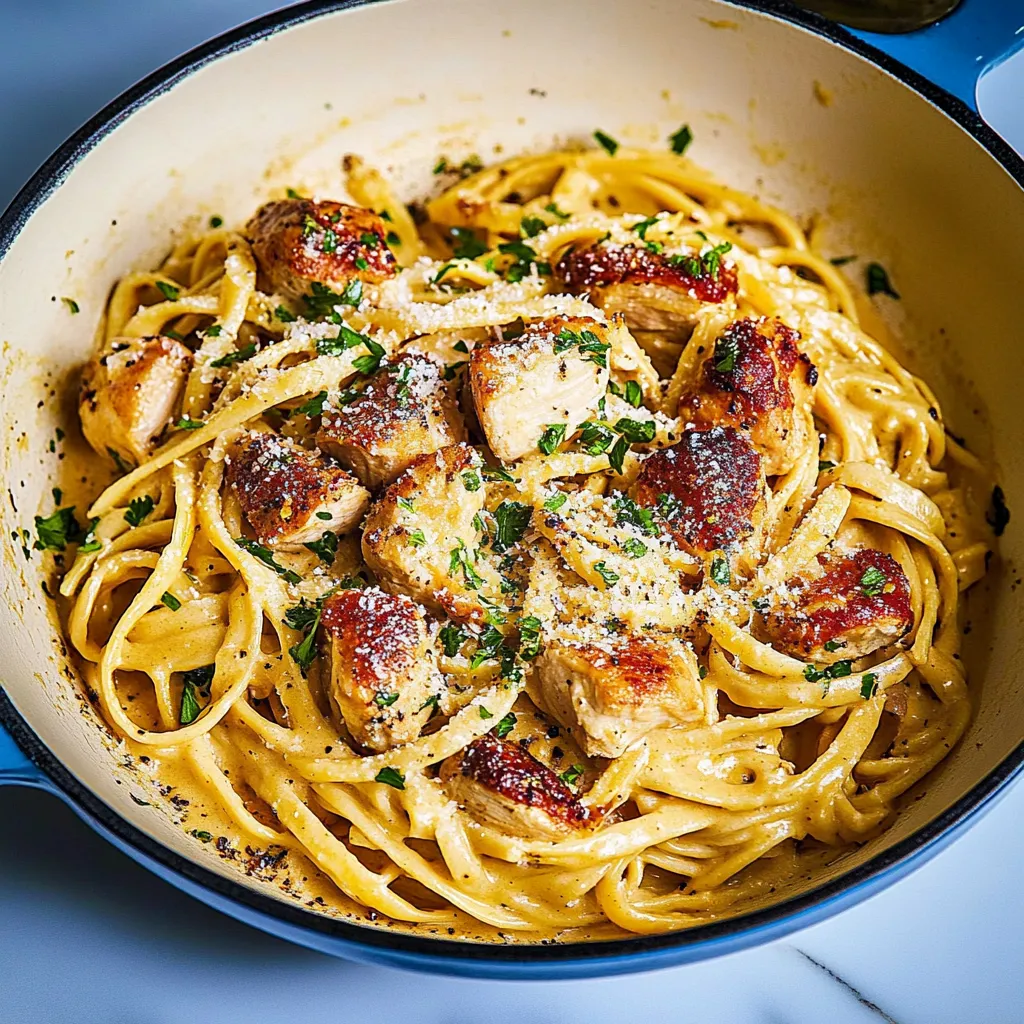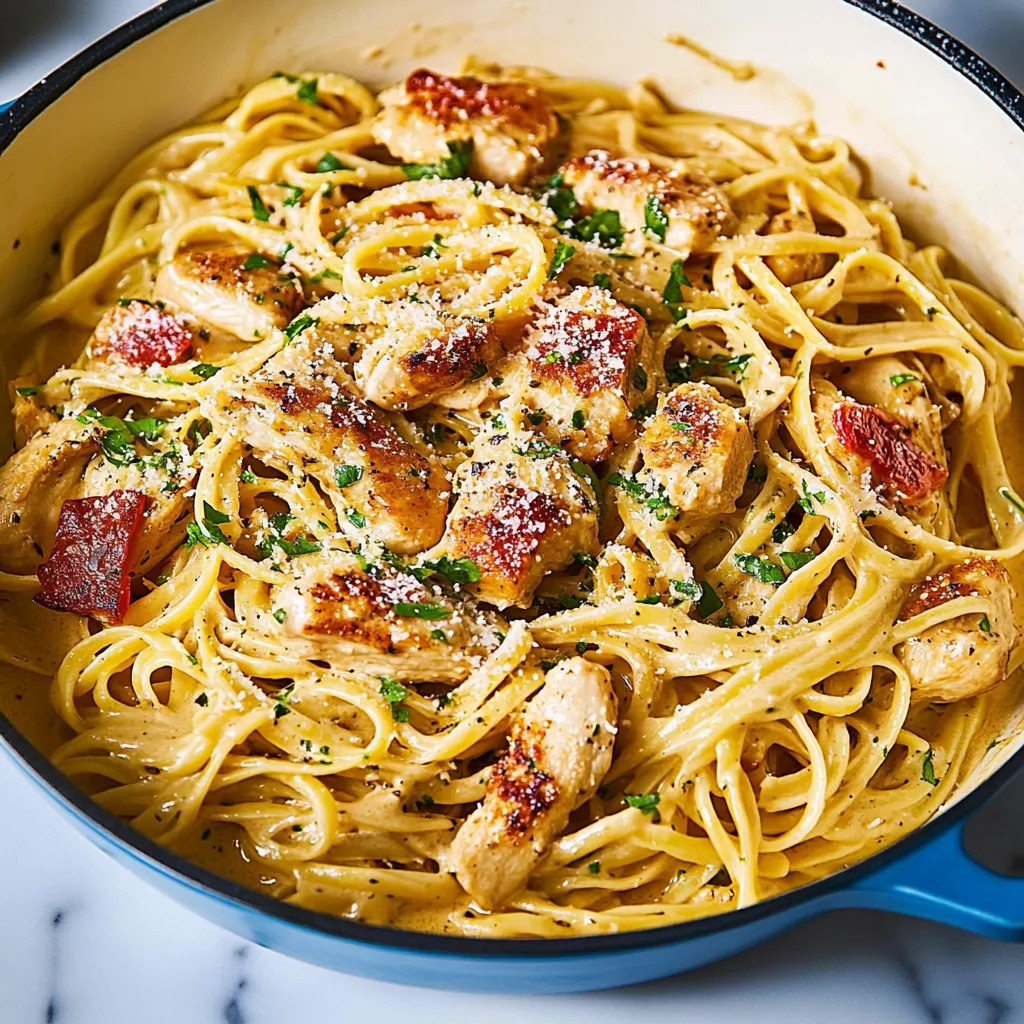 Save
Save
This creamy chicken carbonara pasta combines tender chicken with a velvety egg-based sauce for an indulgent yet simple dinner that always satisfies cravings. The traditional Roman dish gets a protein boost while maintaining all the comforting qualities that make carbonara a beloved classic worldwide.
I first made this chicken carbonara when hosting an impromptu dinner party, and it has since become my go-to dish when I need to impress without spending hours in the kitchen. The way the eggs transform into a silky sauce never fails to delight both family and guests.
Ingredients
- Fettuccine pasta provides the perfect texture to hold the creamy sauce
- Bacon adds that essential smoky flavor that defines carbonara
- Fresh garlic cloves bring aromatic depth to the dish
- Boneless skinless chicken breasts add protein and make this a complete meal
- Eggs create the signature silky sauce without using heavy cream
- Freshly grated Parmesan cheese provides saltiness and thickens the sauce
- Fresh parsley brightens the rich flavors with color and herbal notes
- Pasta water contains starches that help bind the sauce perfectly
Step-by-Step Instructions
- Cook the Pasta
- Boil the fettuccine in generously salted water until just al dente according to package directions. Reserve ½ cup of starchy pasta water before draining this is absolutely crucial for achieving the perfect sauce consistency later.
- Crisp the Bacon
- Cook bacon in a large skillet over medium heat for about 5 minutes until it begins to render its fat. Add minced garlic and continue cooking until the bacon becomes perfectly crispy about 2 to 3 minutes more. The garlic should become fragrant without burning. Transfer this mixture to a bowl and drain half the fat from the skillet.
- Cook the Chicken
- Add chicken strips to the same skillet with remaining bacon fat and increase heat to mediumhigh. Season generously with salt and pepper to develop flavor. Cook for about 10 minutes flipping halfway through until the chicken is completely cooked with no pink remaining.
- Combine Base Ingredients
- Reduce heat to low and return the bacon-garlic mixture to the skillet with the chicken. Add the drained pasta and toss everything together until well combined. This allows the pasta to absorb the flavors from the skillet.
- Prepare the Egg Mixture
- In a separate bowl beat eggs Parmesan and parsley together. Season with salt and pepper. This mixture will transform into the creamy sauce without using any heavy cream an authentic carbonara technique.
- Create the Sauce Magic
- Pour the egg mixture over the hot pasta while the skillet is OFF the heat. Toss quickly until every strand is coated. The residual heat will gently cook the eggs without scrambling them. Add a couple tablespoons of reserved pasta water and toss until creamy adding more water as needed to reach desired consistency.
- Serve Immediately
- Garnish with additional Parmesan and fresh parsley. Serve right away while the sauce is perfectly silky and before it has a chance to thicken too much.
 Save
Save
This recipe brings me back to my first trip to Rome where I discovered that real carbonara has no cream. The way the humble egg transforms into a luxurious sauce feels like culinary magic every time I make it. My family now judges all restaurant carbonaras against this version.
Avoiding Scrambled Eggs
The biggest challenge when making carbonara is preventing the eggs from scrambling. The key is removing the pan from heat before adding the egg mixture. The residual heat from the pasta and pan will gently cook the eggs while you toss vigorously. If your pan is too hot or you add the eggs too slowly you will end up with pasta and scrambled eggs not the silky sauce you want. Always keep tossing continuously until the sauce thickens to coat the pasta strands.
Perfect Substitutions
While this recipe calls for bacon traditional carbonara uses guanciale which is cured pork jowl. Pancetta makes an excellent substitute if available. For the pasta any long strand pasta works well spaghetti is actually more traditional than fettuccine. Pecorino Romano can replace Parmesan for a sharper more authentic flavor. For a lighter version turkey bacon can substitute regular bacon though you may need to add a touch of olive oil to compensate for the reduced fat.
Serving Suggestions
Carbonara is rich and satisfying on its own but pairs beautifully with a crisp green salad dressed simply with lemon and olive oil to cut through the richness. A chilled glass of dry white wine like Pinot Grigio or Sauvignon Blanc complements the creamy sauce perfectly. For a complete Italian meal serve smaller portions as a primo piatto first course followed by a light meat or fish dish. Always serve carbonara immediately after preparing as the sauce thickens significantly as it cools.
The Cultural Context
Carbonara has humble origins in Rome and was popularized after World War II when American soldiers brought bacon and eggs to Italy. Traditional Roman carbonara never includes chicken or garlic but these additions have become popular variations that make the dish more substantial. The name carbonara comes from carbonaro meaning charcoal burner suggesting it was a hearty meal prepared for Italian charcoal workers. Understanding this history helps appreciate how this simple dish of pasta eggs and cured pork has evolved into countless variations while maintaining its core identity.
Recipe FAQs
- → Can I substitute the fettuccine with other pasta types?
Yes, you can easily substitute fettuccine with spaghetti, bucatini, linguine, or capellini. The dish will work well with any long pasta shape that can hold the creamy sauce.
- → Why do you reserve some pasta water?
The starchy pasta water helps create a silky, creamy sauce when combined with the egg mixture. It's the secret to achieving the perfect carbonara consistency without adding cream.
- → How do I prevent the eggs from scrambling?
To prevent scrambling, make sure to remove the pan from direct heat before adding the egg mixture. The residual heat from the pasta and pan will gently cook the eggs without scrambling them.
- → Can I make this dish ahead of time?
Carbonara is best enjoyed immediately after preparation. The sauce tends to thicken and lose its creamy texture when stored or reheated, so it's recommended to serve it fresh.
- → What can I substitute for bacon?
Traditional carbonara uses pancetta or guanciale, which are excellent substitutes for bacon. For a different flavor profile, you could also use prosciutto or for a non-pork option, turkey bacon.
- → Is there a way to make this dish lighter?
For a lighter version, use whole wheat pasta, reduce the amount of bacon, increase the chicken portion, and add some vegetables like peas or asparagus. You can also use some egg whites in place of whole eggs.
